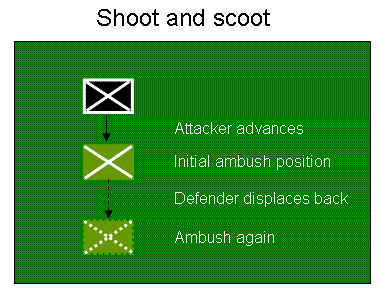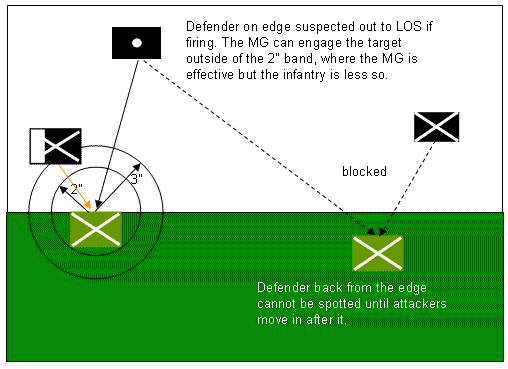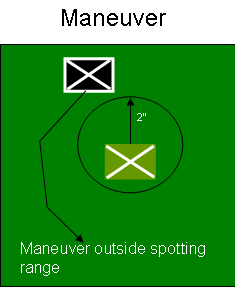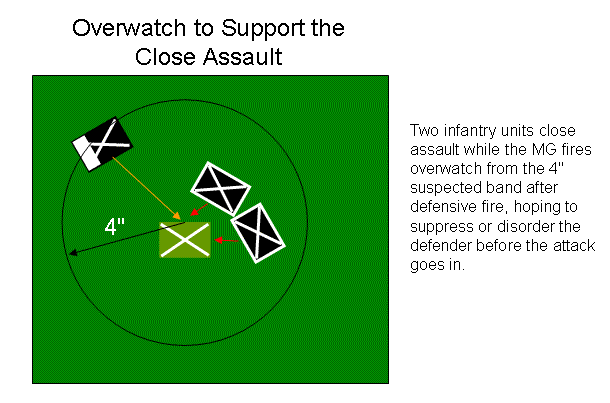Battlefront WWII
Infantry fighting deep in area terrain
Infantry fighting deep in area terrain
Some observations on fighting in area terrain
At Cold Wars 2008, I observed two games where troops were fighting in woods or jungle. Both of these terrain types are considered "Dense Edge/Deep" on the spotting table and this leads to some special tactics that are unique to the terrain type.First, some critical rules:
- (p.19,22) The spotting distances are very short. Dense Edge/Deep spotting distances for troops are 3/1. This can be modified up 1 for moving or spotting, but can often be modified down by 1 by improved position/dug-in status or special rules (Finnish winter camouflage). Your troops will not discover the enemy until you bump into him.
- (p.19,22) The minimum spotting distance is 1. If you get to close combat distance, both the moving unit and the defender are spotted.
- (p.22) The LOS from outside the woods to units deep within dense terrain is blocked unless the spotter is within 1 or has its front aiming point deep in the terrain.
- (p.19,22) The maximum spotting distance within dense area terrain is 4. Because of the suspected target rule for troops that fire (p.18), troops that fire in dense area are suspected out to 4, even if the maximum spotting distance is less.
- Suspected status (p.18) - a unit which is only suspected and changes its position becomes hidden again.
- Ambush fire (p.34) - units get a +1 when they first fire from a hidden position. If they subsequently move to a new position where they are again hidden, they get to use the ambush fire modifier again.
- Opportunity fire (p.33) - disappearing target. If an enemy unit passes out of the LOS of a friendly unit within the first inch of movement, it cannot be targeted for op fire.
- Opportunity fire (p.33) - rapid advance. A target unit conducting a rapid advance can be targeted at any point of its move.
- Displace (p.50). A troop unit may move in any direction at half speed while maintaining its facing.
The above rules lead to some interesting observations:
Shoot and scoot
 The defender in dense terrain often finds himself in a position to use the ambush rule several times in succession. If the attacker is not
within close combat range, the defender will be able to fire once and then displace backwards, disappearing within the first inch of movement (thereby
not triggering op fire), and becoming hidden again. When the attacker moves forward again, the next fire will get the ambush mod as well.
The defender in dense terrain often finds himself in a position to use the ambush rule several times in succession. If the attacker is not
within close combat range, the defender will be able to fire once and then displace backwards, disappearing within the first inch of movement (thereby
not triggering op fire), and becoming hidden again. When the attacker moves forward again, the next fire will get the ambush mod as well.
Deploy back from the edge
 The base spotting distance for units on the edge dense terrain is 3. However, if a unit conformed to the edge fires, it is spotted out to 4 and suspected by any
unit with a clear LOS (such as nasty support weapons, mortars and artillery spotters). One interesting idea which is rarely tried is to put defending units back from
the edge of the terrain, rather than conforming to the edge. If you deploy back from the edge, the LOS is blocked unless the enemy
unit is within 1 or has its forward aiming point deep in the terrain, which will put it within the close-in range band of your weapons.
Of course you forfeit a line of sight out of the terrain, but if you have shorter range weapons, you are not giving up that much and
you will be free from the unwanted attention of support weapons and artillery spotters unless they come in after you. This might be a viable tactic
for the Russians, whose basic infantry unit is at a firepower disadvantage to the Germans in the 2-5 band. If you can force the Germans to
fight you within 1, your basic firepower is equal.
The base spotting distance for units on the edge dense terrain is 3. However, if a unit conformed to the edge fires, it is spotted out to 4 and suspected by any
unit with a clear LOS (such as nasty support weapons, mortars and artillery spotters). One interesting idea which is rarely tried is to put defending units back from
the edge of the terrain, rather than conforming to the edge. If you deploy back from the edge, the LOS is blocked unless the enemy
unit is within 1 or has its forward aiming point deep in the terrain, which will put it within the close-in range band of your weapons.
Of course you forfeit a line of sight out of the terrain, but if you have shorter range weapons, you are not giving up that much and
you will be free from the unwanted attention of support weapons and artillery spotters unless they come in after you. This might be a viable tactic
for the Russians, whose basic infantry unit is at a firepower disadvantage to the Germans in the 2-5 band. If you can force the Germans to
fight you within 1, your basic firepower is equal.Prepared positions
The spotting chart gives a down 1 to units in dug-in positions, improved positions and pillboxes. Deep in dense area terrain, these fortifications are not spotted unless you are within 1, even if they fire (base 1, up 1 for firing, down 1 for the position). If they fire, they are suspected within 4, but their defensive advantage will be cumulative with the suspected modifier to make shooting at them much more difficult. Again, deploying a prepared position inside the terrain instead of on the edge makes them even tougher.Maneuver is possible close to the enemy
 Because troops which move through dense terrain are usually spotted only out to 2, it is possible to bypass enemy units rather than engaging them. This
is more of a viable tactic in terrain that allows rapid advance (often jungle does not). If you can get behind him, the shoot and scoot defensive
tactic will no longer work.
Because troops which move through dense terrain are usually spotted only out to 2, it is possible to bypass enemy units rather than engaging them. This
is more of a viable tactic in terrain that allows rapid advance (often jungle does not). If you can get behind him, the shoot and scoot defensive
tactic will no longer work.
Close assault when moving up
Occasionally it is necessary to close. Unless the enemy is fighting from a position that cannot be abandoned, you must move within 1 to avoid shoot and scoot. Otherwise you will be subject to multiple ambushes that will whittle your forces down by attrition without getting a chance to reply. If you do move within 1, you may want to close assault immediately. Try to get 2 or 3 units in each assault, because the ambush fire can be deadly.Overwatch with support weapons (MMG, LMG)
 Because of the short spotting ranges, normal base of fire tactics are difficult to use. Your MGs usually won't be close enough to shoot
in the direct fire phase. Most people respond by throwing them into the assault. However, try putting the MG units (which usually have lower CC values)
on overwatch. If you are close assaulting with other units, the defender will shoot defensive fire against them and is suspected to all units with clear LOS within 4.
Overwatching MGs can shoot before the close-assault is resolved, often disordering or suppressing the defender for a crucial die roll modifier in
the assault. We are accustomed to the suspected modifier of -2 rendering fire ineffective, because it usually takes place at long range and
adds insult to the injury of a negative weapon rating. However, in dense terrain, the fire is within the "under 5" range band.
Most MGs are +1 or +2 at that range, so the overwatch fire will usually be resolved at worst with a -1 or -2 final modifier
(weapon rating +1 or +2, suspected -2, cover -1), which is quite capable of being effective.
Because of the short spotting ranges, normal base of fire tactics are difficult to use. Your MGs usually won't be close enough to shoot
in the direct fire phase. Most people respond by throwing them into the assault. However, try putting the MG units (which usually have lower CC values)
on overwatch. If you are close assaulting with other units, the defender will shoot defensive fire against them and is suspected to all units with clear LOS within 4.
Overwatching MGs can shoot before the close-assault is resolved, often disordering or suppressing the defender for a crucial die roll modifier in
the assault. We are accustomed to the suspected modifier of -2 rendering fire ineffective, because it usually takes place at long range and
adds insult to the injury of a negative weapon rating. However, in dense terrain, the fire is within the "under 5" range band.
Most MGs are +1 or +2 at that range, so the overwatch fire will usually be resolved at worst with a -1 or -2 final modifier
(weapon rating +1 or +2, suspected -2, cover -1), which is quite capable of being effective.Note that I actually haven't seen this one used, but it seems to be allowed within the rules.
Improve your positions
Every unit that is not moving or fighting should attempt to improve their position. There is a "down 1" on the spotting chart that will prevent troops in IP from being spotted beyond 1, even if they fire (p.20). Note that while IPs also give a benefit when rolling on the maneuver chart (p.45), you get this while in cover, so there is no additional bonus.Here, kitty, kitty, kitty...
Dense area terrain is infantry country and vehicles enter it to their peril. First, the terrain will usually give the infantry a cover modifier against defensive fire. Then the close combat modifier "-2 ATT/DEF vehicle vs troops in concealment" (p.56) makes even weak infantry units almost equal to big tanks. For example, the close combat strength of a Panther vs T is +4, a Tiger has a +5. The CC strength of a Russian rifle unit vs V is +1. However, in the woods, the concealment modifier makes the Panther a +2 and the Tiger a +3, giving the tanks a +1 and +2 advantage respectively. Using the close combat calculator shows that a +1 and +2 is far from a sure thing on the attack (and there is always that pesky 8-9% chance of a tie with both sides losing a unit). On the offense in woods, infantry often can swarm a vehicle, hitting it with 3 or 4 attacks at -1 or -2 and taking the best roll. This often can result in a win for the infantry, or an "exchange", which is a win for the side commanding the infantry, if not the individual stand (would you trade a Russian rifle stand for a Tiger - I know I would).Winter Finns - Rulers of the woods
I have seen the Steve Keyer's Finnish Counterattack scenario from the White Death scenario book played 3 times at conventions. Every time, the Finnish players launched WWI style frontal assaults across open terrain into the teeth of Russian defenses with predictable results. These tactics ignore the most important advantage the Finns have, their winter camouflage, which is down 1 on the spotting chart. In the open, the effects are obvious but not decisive. Finnish infantry normally can be seen moving within 10 instead of 20, but an FO or height advantage still allows the Russian to pick them up at a reasonable distance.However - in the woods...
The down one modifier in the woods means that the Finns cannot be spotted beyond 1, even while moving. In addition to making the usual flanking maneuvers easier, if they find or create (by fighting) a gap in a defensive line that is over 2", they can infiltrate through it without getting fired on, quickly penetrating into the rear.
If they fire, they are just suspected from 1-2, not spotted (they are still suspected out to 4, but only spotted within 1). This allows them to move up into close weapon range of the enemy without fear of defensive fire. Their MGs on overwatch can be set up within 2 of the enemy and will not be subject to the suspected modifier. Overwatching with infantry is viable as well. This is almost as good as a mobile improved position!
Finally, units which are not suspected or spotted (i.e. Finnish troops at 1-2 which have moved into close range without being seen), get an ambush modifier when they first shoot! Offensive ambush has the potential to be an extremely devastating tactic.
Be wary of engaging Finns (or other units with special camouflage) in the woods.